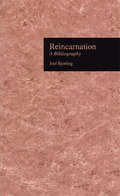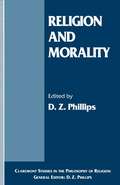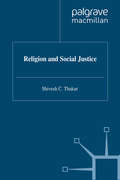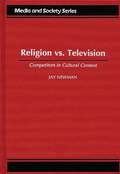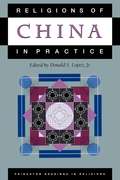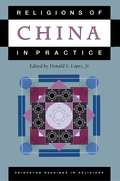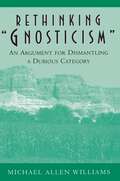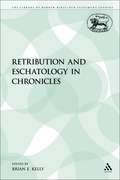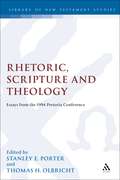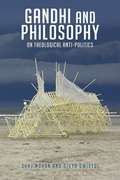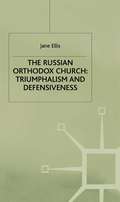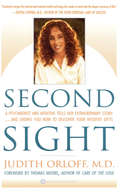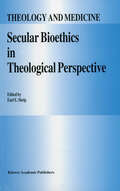- Table View
- List View
Reincarnation: A Bibliography (Sects and Cults in America)
by Joel BjorlingFirst Published in 1996. Routledge is an imprint of Taylor & Francis, an informa company.
Reliable Characters in the Primary History: Profiles of Moses, Joshua, Elijah and Elisha (The Library of Hebrew Bible/Old Testament Studies)
by Paul J. KisslingThis volume challenges the assumptions that modern readers tend to make about four of the Hebrew Bible's most prominent heroes. Using a form of reader-response theory, Kissling examines the assumption that these characters are primary vehicles of the narrator's point of view. In three of the four cases it is concluded that traditional idealistic assumptions do not do justice to the textual evidence in its final form. The work calls upon the reader to consider the subtlety of the means used in portraying these heroes and gives evidence for the decidedly negative aspects in their portrayals.
Religion and Human Rights: An Introduction (Emory University Studies In Law And Religion Ser.)
by John Witte Jr. M. Christian GreenThe relationship between religion and human rights is both complex and inextricable. While most of the world's religions have supported violence, repression, and prejudice, each has also played a crucial role in the modern struggle for universal human rights. Most importantly, religions provide the essential sources and scales of dignity and responsibility, shame and respect, restraint and regret, restitution and reconciliation that a human rights regime needs to survive and flourish in any culture. With contributions by a score of leading experts, Religion and Human Rights provides authoritative and accessible assessments of the contributions of Judaism, Christianity, Islam, Hinduism, Confucianism, Buddhism, and Indigenous religions to the development of the ideas and institutions of human rights. It also probes the major human rights issues that confront religious individuals and communities around the world today, and the main challenges that the world's religions will pose to the human rights regime in the future.
Religion and Justice in the War Over Bosnia
by G. Scott DavisThis volume brings together a distinguished group of thinkers, working in ethics, religion and history, to explore moral and religious issues that underlie the violence in Bosnia. ********************************************************* This volume brings together a distinguished group of thinkers to explore the moral and religious issues that underlie the violence and atrocities in Bosnia. From diverse academic and philosophical perspectives, the works of Jean Bethke Elshtain, James Turner Johnson, Michael Sells, John Kelsay, and G. Scott Davis will inform not just scholars of ethics, politics and religion, but everyone concerned with the prospects for justice in the post Cold War world.
Religion and Justice in the War Over Bosnia
by G. Scott DavisThis volume brings together a distinguished group of thinkers, working in ethics, religion and history, to explore moral and religious issues that underlie the violence in Bosnia. ********************************************************* This volume brings together a distinguished group of thinkers to explore the moral and religious issues that underlie the violence and atrocities in Bosnia. From diverse academic and philosophical perspectives, the works of Jean Bethke Elshtain, James Turner Johnson, Michael Sells, John Kelsay, and G. Scott Davis will inform not just scholars of ethics, politics and religion, but everyone concerned with the prospects for justice in the post Cold War world.
Religion and Morality (Claremont Studies in the Philosophy of Religion)
by D. Z. PhillipsReflection on religion inevitably involves consideration of its relation to morality. When great evil is done to human beings, we may feel that something absolute has been violated. Can that sense, which is related to gratitude for existence, be expressed without religious concepts? Can we express central religious concerns, such as losing the self, while abandoning any religious metaphysic? Is moral obligation itself dependent on divine commands if it is to be objective, or is morality not only independent of religion, but its accuser if God is said to allow horrendous evils? In any case, what happens to the absolute claims of religion in what is, undeniably, a morally pluralistic world? These are the central questions discussed by philosophers of religion and moral philosophers in this collection. They do so in ways which bring new aspects to bear on these traditional issues.
Religion and Social Justice (Library of Philosophy and Religion)
by S. ThakurThis book is a philosophical examination of the relationship between religion and social justice. Its main thesis is that, since the primary purpose of religion is the moral and spiritual transformation of human nature, it ought not to be construed as a direct instrument of social justice on earth - as it is by Liberation theologians, for example, as well as by many liberal Christians and Jews. Indirectly, however, religion may well be a pre-condition of social justice. For it can be argued that, without the counteracting effects of the moral and spiritual values prescribed by religion, the liberal vision of individual rights and social justice may be self-defeating. Humanity is best served if this liberal vision is counterbalanced by the completely contrary utopia enshrined in the biblical idea of the kingdom of God, and its equivalents in the other great religions of the world.
Religion and the Rise of Democracy
by Graham MaddoxIn a major original study, Graham Maddox analyses the role of religion in the development of democracy from the tribes of ancient Israel to the present day. The book contrasts Athenian direct democracy with the Old Testament monarchy in which the concept of religious opposition - vital to modern democracy - arose. Maddox then develops his discussion of the relationship between religion and democracy through early christianity to the Reformation and Calvinism, ending with a chapter on modern democracy. Maddox's contentious thesis concerning the development of democracy is truly interdisciplinary drawing on political science, religious history and theology.
Religion and the Rise of Democracy
by Graham MaddoxIn a major original study, Graham Maddox analyses the role of religion in the development of democracy from the tribes of ancient Israel to the present day. The book contrasts Athenian direct democracy with the Old Testament monarchy in which the concept of religious opposition - vital to modern democracy - arose. Maddox then develops his discussion of the relationship between religion and democracy through early christianity to the Reformation and Calvinism, ending with a chapter on modern democracy. Maddox's contentious thesis concerning the development of democracy is truly interdisciplinary drawing on political science, religious history and theology.
Religion in the Soviet Union: An Archival Reader
by F. CorleyThe Soviet government's attitude to religion in theory and practice is shown in this wide-ranging collection of annotated texts from the newly-opened archives. Included are documents from the KGB, the Central Committee, the Council for Religious Affairs and numerous other official bodies. For the first time in English we see the bureaucrats' own view of how religious believers should be controlled, following the story from the persecutions of the early Soviet years to the openness instituted by Mikhail Gorbachev.
Religion vs. Television: Competitors in Cultural Context (Media and Society Series)
by Jay NewmanThe subject of competition between religion and television has, if only indirectly, received considerable attention, particularly from religionists disturbed by the threat posed by television programming to traditional religious beliefs, values, and attitudes. This detailed study considers the competing cultural forces of television and religion from a wider and more theoretical perspective. Newman examines the major forms of competition and the various motives and strategies of the people and groups involved. His philosophical approach allows us to see that the most important aspect of competition between television and religion is their rivalry as cultural forces. In this rivalry, religion continues to have a profound influence on the shaping of television, just as it has always had on all newly developing forms of culture.
Religions of China in Practice
by Donald S. Lopez Jr.This third volume of Princeton Readings in Religions demonstrates that the "three religions" of China--Confucianism, Daoism, and Buddhism (with a fourth, folk religion, sometimes added)--are not mutually exclusive: they overlap and interact with each other in a rich variety of ways. The volume also illustrates some of the many interactions between Han culture and the cultures designated by the current government as "minorities." Selections from minority cultures here, for instance, are the folktale of Ny Dan the Manchu Shamaness and a funeral chant of the Yi nationality collected by local researchers in the early 1980s. Each of the forty unusual selections, from ancient oracle bones to stirring accounts of mystic visions, is preceded by a substantial introduction. As with the other volumes, most of the selections here have never been translated before. Stephen Teiser provides a general introduction in which the major themes and categories of the religions of China are analyzed. The book represents an attempt to move from one conception of the "Chinese spirit" to a picture of many spirits, including a Laozi who acquires magical powers and eventually ascends to heaven in broad daylight; the white-robed Guanyin, one of the most beloved Buddhist deities in China; and the burning-mouth hungry ghost. The book concludes with a section on "earthly conduct."
Religions of China in Practice (Princeton Readings in Religions #37)
by Donald S. LopezThis third volume of Princeton Readings in Religions demonstrates that the "three religions" of China--Confucianism, Daoism, and Buddhism (with a fourth, folk religion, sometimes added)--are not mutually exclusive: they overlap and interact with each other in a rich variety of ways. The volume also illustrates some of the many interactions between Han culture and the cultures designated by the current government as "minorities." Selections from minority cultures here, for instance, are the folktale of Ny Dan the Manchu Shamaness and a funeral chant of the Yi nationality collected by local researchers in the early 1980s. Each of the forty unusual selections, from ancient oracle bones to stirring accounts of mystic visions, is preceded by a substantial introduction. As with the other volumes, most of the selections here have never been translated before. Stephen Teiser provides a general introduction in which the major themes and categories of the religions of China are analyzed. The book represents an attempt to move from one conception of the "Chinese spirit" to a picture of many spirits, including a Laozi who acquires magical powers and eventually ascends to heaven in broad daylight; the white-robed Guanyin, one of the most beloved Buddhist deities in China; and the burning-mouth hungry ghost. The book concludes with a section on "earthly conduct."
Rethinking Borders
by John C. WelchmanThe condition of borders has been crucial to many recent exhibitions, conferences and publications. But there does not yet exist a convincing critical frame for the discussion of border discourses. Rethinking Borders offers just such an introduction. It develops important contexts in art and architectural theory, contemporary film-making, criticism and cultural politics, for the proliferation of 'border theories' and 'border practices' that have marked a new stage in the debates over postmodernism, cultural studies and postcolonialism.
Rethinking "Gnosticism": An Argument for Dismantling a Dubious Category
by Michael Allen WilliamsMost anyone interested in such topics as creation mythology, Jungian theory, or the idea of "secret teachings" in ancient Judaism and Christianity has found "gnosticism" compelling. Yet the term "gnosticism," which often connotes a single rebellious movement against the prevailing religions of late antiquity, gives the false impression of a monolithic religious phenomenon. Here Michael Williams challenges the validity of the widely invoked category of ancient "gnosticism" and the ways it has been described. Presenting such famous writings and movements as the Apocryphon of John and Valentinian Christianity, Williams uncovers the similarities and differences among some major traditions widely categorized as gnostic. He provides an eloquent, systematic argument for a more accurate way to discuss these interpretive approaches. The modern construct "gnosticism" is not justified by any ancient self-definition, and many of the most commonly cited religious features that supposedly define gnosticism phenomenologically turn out to be questionable. Exploring the sample sets of "gnostic" teachings, Williams refutes generalizations concerning asceticism and libertinism, attitudes toward the body and the created world, and alleged features of protest, parasitism, and elitism. He sketches a fresh model for understanding ancient innovations on more "mainstream" Judaism and Christianity, a model that is informed by modern research on dynamics in new religious movements and is freed from the false stereotypes from which the category "gnosticism" has been constructed.
Retribution and Eschatology in Chronicles (The Library of Hebrew Bible/Old Testament Studies)
by Brian E. KellyThe Jews who returned from exile in Babylonia to Jerusalem and Judah faced difficult and straitened times, in which the bright hopes of the Restoration had faded. The Chronicler wrote his history partly to encourage his community to have faith in God's ancient promises to David, that better things would come to a penitent people. Although not often recognized as such, the books of Chronicles belong to the mainstream of biblical teaching on divine grace and hope, as the present study shows by analysing its themes of reward and punishment, and its teaching on the future. It differs significantly from the interpretation given by Sara Japhet in her monograph on Chronicles of 1989 and her major new commentary of 1993.
Rhetoric, Scripture and Theology: Essays from the 1994 Pretoria Conference (The Library of New Testament Studies #131)
by Stanley E. Porter Thomas H. OlbrichtRhetoric, Scripture and Theology aptly describe the contents of this collection of essays from the 1994 Pretoria Rhetoric Conference. The conference marked a significant dialogue among scholars gathered from many nations to consider how rhetoric engages with the study of scripture and theology. South Africa provided a suitable context for such discussion. Although the contributors are not only from South Africa, the addressing of issues pertinent to a South African context shows through in many of the essays. Those that do not address particularly South African issues raise equally important issues regarding the topic of rhetoric and its relation to contemporary theological discourse.
Rise and Fall of the Nine O'Clock Service
by Roland HowardCovers the story of "The Nine O'Clock Service" in Sheffield which received heavy publicity in 1995, following the exposure of scandals and abuses at the hands of the leader, Chris Brain. This book follows the development of the church and draws comparisons with other alternative churches.
The Rise of Christianity: A Sociologist Reconsiders History
by Rodney StarkThe idea that Christianity started as a clandestine movement among the poor is a widely accepted notion. Yet it is one of many myths that must be discarded if we are to understand just how a tiny messianic movement on the edge of the Roman Empire became the dominant faith of Western civilization. In a fast-paced, highly readable book that addresses beliefs as well as historical facts, Rodney Stark brings a sociologist's perspective to bear on the puzzle behind the success of early Christianity. He comes equipped not only with the logic and methods of social science but also with insights gathered firsthand into why people convert and how new religious groups recruit members. He digs deep into the historical evidence on many issues--such as the social background of converts, the mission to the Jews, the status of women in the church, the role of martyrdom--to provide a vivid and unconventional account of early Christianity. The author plots the most plausible curve of Christian growth from the year 40 to 300. By the time of Constantine, Christianity had become a considerable force, with growth patterns very similar to those of modern-day successful religious movements. An unusual number of Christian converts, for example, came from the educated, cosmopolitan classes. Because it offered a new perspective on familiar concepts and was not linked to ethnicity, Christianity had a large following among persons seeking to assimilate into the dominant culture, mainly Hellenized Jews. The oversupply of women in Christian communities--due partly to the respect and protection they received--led to intermarriages with pagans, hence more conversions, and to a high fertility rate. Stark points out, too, the role played by selflessness and faith. Amidst the epidemics, fires, and other disasters that beleaguered Greco-Roman cities, Christian communities were a stronghold of mutual aid, which resulted in a survival rate far greater than that of the pagans. In the meantime, voluntary martyrdom, especially a generation after the death of Christ, reinforced the commitment of the Christian rank and file. What Stark ultimately offers is a multifaceted portrait of early Christianity, one that appeals to practical reasoning, historical curiosity, and personal reflection.
The Rise of Christianity: A Sociologist Reconsiders History
by Rodney StarkThe idea that Christianity started as a clandestine movement among the poor is a widely accepted notion. Yet it is one of many myths that must be discarded if we are to understand just how a tiny messianic movement on the edge of the Roman Empire became the dominant faith of Western civilization. In a fast-paced, highly readable book that addresses beliefs as well as historical facts, Rodney Stark brings a sociologist's perspective to bear on the puzzle behind the success of early Christianity. He comes equipped not only with the logic and methods of social science but also with insights gathered firsthand into why people convert and how new religious groups recruit members. He digs deep into the historical evidence on many issues--such as the social background of converts, the mission to the Jews, the status of women in the church, the role of martyrdom--to provide a vivid and unconventional account of early Christianity. The author plots the most plausible curve of Christian growth from the year 40 to 300. By the time of Constantine, Christianity had become a considerable force, with growth patterns very similar to those of modern-day successful religious movements. An unusual number of Christian converts, for example, came from the educated, cosmopolitan classes. Because it offered a new perspective on familiar concepts and was not linked to ethnicity, Christianity had a large following among persons seeking to assimilate into the dominant culture, mainly Hellenized Jews. The oversupply of women in Christian communities--due partly to the respect and protection they received--led to intermarriages with pagans, hence more conversions, and to a high fertility rate. Stark points out, too, the role played by selflessness and faith. Amidst the epidemics, fires, and other disasters that beleaguered Greco-Roman cities, Christian communities were a stronghold of mutual aid, which resulted in a survival rate far greater than that of the pagans. In the meantime, voluntary martyrdom, especially a generation after the death of Christ, reinforced the commitment of the Christian rank and file. What Stark ultimately offers is a multifaceted portrait of early Christianity, one that appeals to practical reasoning, historical curiosity, and personal reflection.
The Russian Orthodox Church: Triumphalism and Defensiveness (St Antony's Series)
by Jane EllisThe Russian Orthodox Church has survived more than seventy years of the most brutal and sustained attempts to eradicate religion that has ever been. Weakened but spiritually alive, it is confronted by the demands of a ravaged, exhausted society. Can it, however, find the resources and energy to respond to these demands? Jane Ellis describes the developments and problems in the Russian Orthodox Church under glasnost and especially since the new freedoms were granted following the millennium celebrations of 1988. New opportunities mean new challenges and demand huge new resources. Old problems in the form of close State and KGB contacts remain, and new problems in the form of competition from other denominations and sects arise. Traditionally the Orthodox Church has enjoyed a 'symphony' with the State. However are unhealthy links with the KGB and the communist past still damaging the Church. Is it in danger of becoming a state church?
Second Sight: An Intuitive Psychiatrist Tells Her Extraordinary Story And Shows You How To Tap Your Own Inner Wisdom
by Judith OrloffIn this compelling self-portrait, psychic and psychiatrist Dr. Judith Orloff, "one of the frontier people in health, who was not satisfied with the existing order, the Establishment, and began to push for the expansion of knowledge which the establishment, of course, often rejected and for which it sough to punish them," (The Nation Magazine) draws on her own experience and that of her patients to explore the mysterious and poorly understood realm of the psychic.In riveting detail, she describes how an ignored premonition of a patient's suicide attempt convinced her to embrace her gift and incorporate it into her medical practice--and how using psychic abilities can provide powerful healing. More than simply one woman's journey, this book will also outline effective ways to cultivate natural psychic abilities, including how to--recognize psychic experiences in everyday life--increase clairvoyance--practice psychic exercises--discover psychic empathy--tune into messages the body is sending--record and interpret dreams--and more.
Secular Bioethics in Theological Perspective (Theology and Medicine #8)
by E. E. ShelpTheologians and theologically educated participants in discussions of bioethics have been placed on the defensive during recent years. The dominance of religious perspectives and theological voices that marked the emergence and establishment of "bioethics" in the late 1960s and 1970s has eroded steadily as philosophers, lawyers, and others have relativized their role and influ ence, at best, or dismissed it entirely, at worst. The secularization of bioethics, which has occurred for a variety of reasons, has prompted some prominent writers to reflect on what has been lost. Daniel Callahan, for example writes, " . . . whatever the ultimate truth status of religious perspectives, they have provided a way of looking at the world and understanding one's own life that has a fecundity and uniqueness not matched by philosophy, law, or political theory. Those of us who have lost our reli gious faith may be glad that we have discovered what we take to be the reality of things, but we can still recognize that we have also lost something of great value as well: the faith, vision, insights, and experience of whole peoples and traditions who, no less than we unbelievers, struggled to make sense of things. That those goods are part of a garment we no longer want to wear does not make their loss anything other than still a loss; and it is not a neglible one" ([2], p. 2).
Selected Poems of Shmuel HaNagid
by Shmuel Hanagid Peter ColeThe first major poet of the Hebrew literary renaissance of Moslem Spain, Shmuel Ben Yosef Ha-Levi HaNagid (993-1056 c.e.) was also the Prime Minister of the Muslim state of Granada, battlefield commander of the non-Jewish Granadan army, and one of the leading religious figures in a medieval Jewish world that stretched from Andalusia to Baghdad. Peter Cole's groundbreaking versions of HaNagid's poems capture the poet's combination of secular and religious passion, as well as his inspired linking of Hebrew and Arabic poetic practice. This annotated Selected Poems is the most comprehensive collection of HaNagid's work published to date in English. "The Multiple Troubles of Man" The multiple troubles of man,my brother, like slander and pain,amaze you? Consider the heartwhich holds them allin strangeness, and doesn't break. "I'd Suck Bitter Poison from the Viper's Mouth" I'd suck bitter poison from the viper's mouthand live by the basilisk's hole forever,rather than suffer through evenings with boors,fighting for crumbs from their table.
Sex, Honor, and Power in the Deuteronomistic History (The Library of Hebrew Bible/Old Testament Studies)
by Kenneth StoneIn this original work, Stone studies the structure and social presuppositions of several narratives from the Deuteronomistic History in which sexual activity plays a significant role. Both narratological and anthropological tools are utilized in the textual analysis. Stone interestingly notes the link between sexual activity, gender and prestige structures; the emphasis on male contest and female chastity discussed by anthropologists of honour and shame; and the role of the exchange of women in relations between men. In each story, sexual practice is primarily related to male struggles for honour and power.
